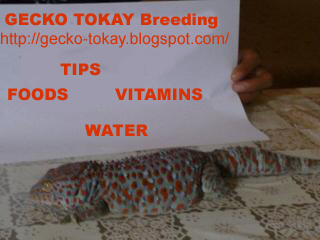That wasn't easy. A friend climbed a mango tree where bamboo's were hanged for many months ago. The native said, tukos lived there. We found out that a family of tuko, mother, father,offsprings and unhatched eggs were inside bamboo. The little geckos were too brisk.The parents were on their attack mode.Meanwhile, my friends prepared another bamboo cut with screen. Unfortunately, some little geckos escaped through the screen. As first timer to wild-hunting event, I couldn't stay even closer. Honestly, when I took the picture, it was in Auto Mode because I didn't want to hear the geckos "To-key" sound and stepped back after a fast camera capture.
 |
| I and a friend forcibly transfer 5 geckos to a customized cage. |
Tokays are a robust, colorful gecko with grey/blue body and red/orange and white spots. Their red tongue and black throat is displayed during their aggressive/defensive gape display.Tokay geckos are an arboreal species (tree-dwelling and cliff-dwelling) found mainly in rainforests, but in many parts of their natural range they are common in houses and urban areas. The Tokay originates from southeast Asia and is commonly found in Thailand, Indonesia, Malaysia, Vietnam, China and Japan. In their native regions Tokays are often considered welcome house guests as they eat pest insects and act as good vermin control. They are also seen as harbingers of good luck in many Asian cultures and to have a Tokay in your house is a sign of a happy home, They can often be found on walls and ceilings and commonly around lamps and other sources of light that attract insects at night.
 Female Tokays are also capable of making the same calling sound but are generally quieter and less likely to call as often as the males. Tokays can also produce a range of clicks, barks and squeaking sounds and are widely recognized as the most vocal of all the geckos.
They also have a distinctive "gaping" characteristic in which they open their mouths wide and puff themselves up in a defensive display if they feel threatened. Their life span around 6-10 years in the wild but can be anything up to 20+ years in captivity. Males are around 30-40cm in length, females are 20-28cm. A healthy weight can range between 150-300g dependent on age and sex.
Back to the hunting. I was deeply feeling sad when we have discovered several eggs were damaged after a series of bamboo knocking.Somehow, it pointed me to a realization. We keep on damaging the mother nature. We abused its authenticity. We went beyond what is due to us. We have killed animals for industrial use.But, at the end of the day, the ultimate cure for a once century-long-incurable disease such AIDS and CANCER is the fruit of nature itself. The Gecko.
Female Tokays are also capable of making the same calling sound but are generally quieter and less likely to call as often as the males. Tokays can also produce a range of clicks, barks and squeaking sounds and are widely recognized as the most vocal of all the geckos.
They also have a distinctive "gaping" characteristic in which they open their mouths wide and puff themselves up in a defensive display if they feel threatened. Their life span around 6-10 years in the wild but can be anything up to 20+ years in captivity. Males are around 30-40cm in length, females are 20-28cm. A healthy weight can range between 150-300g dependent on age and sex.
Back to the hunting. I was deeply feeling sad when we have discovered several eggs were damaged after a series of bamboo knocking.Somehow, it pointed me to a realization. We keep on damaging the mother nature. We abused its authenticity. We went beyond what is due to us. We have killed animals for industrial use.But, at the end of the day, the ultimate cure for a once century-long-incurable disease such AIDS and CANCER is the fruit of nature itself. The Gecko.

 Female Tokays are also capable of making the same calling sound but are generally quieter and less likely to call as often as the males. Tokays can also produce a range of clicks, barks and squeaking sounds and are widely recognized as the most vocal of all the geckos.
Female Tokays are also capable of making the same calling sound but are generally quieter and less likely to call as often as the males. Tokays can also produce a range of clicks, barks and squeaking sounds and are widely recognized as the most vocal of all the geckos.


